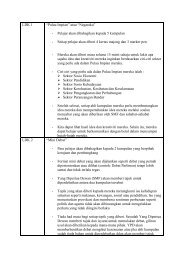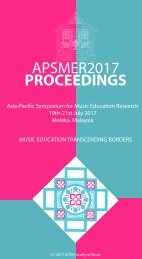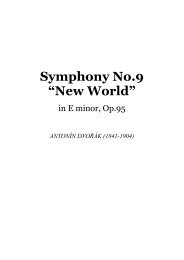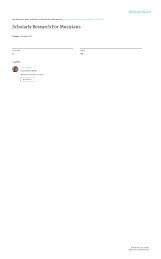APSMER2017 PROCEEDINGS
Create successful ePaper yourself
Turn your PDF publications into a flip-book with our unique Google optimized e-Paper software.
Proceedings of the 11th Asia-Pacific Symposium for Music Education Research<br />
(APSMER 2017) 19th to 21st July 2017, Melaka MALAYSIA<br />
their natural style in order for discerning the players’ primary ideas and their<br />
understanding of the music.<br />
Yu:<br />
I always request the players to play the whole piece of music<br />
before beginning my instruction. Otherwise, I cannot get the<br />
players’ preferred natural style.<br />
The three teachers rarely proposed concrete directions for musical<br />
expression in their session. Instead, they often used metaphorical languages<br />
and encouraged players to try ‘an experimental performance’ to extract new<br />
ideas for musical expression. For example, Taku requested the players to<br />
invent lyrics to fit the music and to sing. This request started the players off<br />
talking about not only an imaginal story but also a mood and an emotion that<br />
they felt from the music. After this activity, the players made their musical<br />
expression absolutely different to the previous one.<br />
The teachers often lead to focus on a critical point of music without<br />
suggesting any direction for a change of expression neither directly nor<br />
euphemistically. Those directions often extracted changes of timing,<br />
dynamics and duration of particular notes including a derived note for a key<br />
transition and an appoggiatura.<br />
In the latter half of their session, teachers requested players to listen to<br />
each other’s sounds to make an interactive performance. Ken used the word<br />
“talk musically” to promote collaborative problem-solving.<br />
Ken:<br />
It is better to play the music by talking musically to each other.<br />
“You gave it to me, then I’ll give this back to you.” “That ignited<br />
me!” I like such conversations.<br />
Overall, the three teachers showed their mood to promote the players<br />
to take an initiative. However, teachers took their initiative when they<br />
demanded collections of obvious problems including asynchronous rhythms<br />
and inapt senses of meter.<br />
The teachers assessed not only sounds but also changes of the players’<br />
thinking during the performance with the players’ verbal reactions to the<br />
teachers’ direction and body movement with the music.<br />
39








